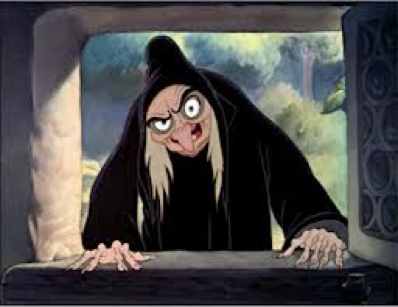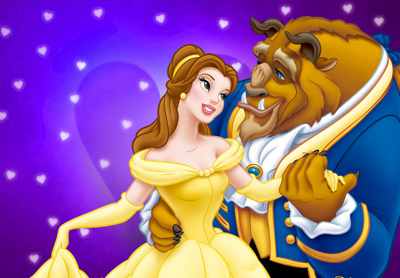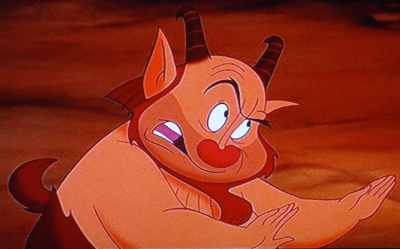(单词翻译:单击)
5.Ugliness is Immoral
5.丑陋等于邪恶
In almost every Disney movie the primary antagonist is portrayed as physically unattractive, encouraging children to associate this character trait with evil. Female characters are particularly subjected to this treatment, all having at least one of the "Big Three" of Disney villain characteristics: being fat (Ursula in "The Little Mermaid"), old (The Old Woman in "Snow White") or hideously ugly (The Ugly Stepsisters in "Cinderella"). The bottom line is that Disney openly preaches that attractiveness is synonymous with both morality and happiness. Disney villains are often portrayed as insecure about their appearance, which then causes them to take it out on younger, slimmer, better-looking characters. For example the villain of "Snow White" is obsessed with being the "fairest of them all", and the ugly stepsisters bully and abuse innocent beautiful Cinderella.
几乎每一部迪士尼电影中的大反派都长得穷凶极恶,鼓励小朋友们将这样的角色与邪恶联想在一起。尤其是女性角色,至少符合迪士尼反派角色的"三大特点"中的一点:身形彪悍(《小美人鱼》中的厄休拉),年老(《白雪公主》中的老妇人)或者长相其丑无比(《灰姑娘》中丑陋的继姐妹)。总而言之,迪士尼的观点是长相迷人就等同于道德高尚和幸福美满。迪士尼的反派们对于他们自己的相貌都很没有自信,他们因此嫉妒年轻、苗条、美丽的主角们并且拿她们出气。例如《白雪公主》中的皇后一直沉醉在成为"世界上最美丽的人"的美梦中,还有丑陋的继姐妹虐待美丽天真的灰姑娘。

4.Beauty is Moral
4.美丽等于道德高尚

The film "Beauty and the Beast" works on the pretence of "looks don't matter". However a closer look at the plot structure reveals this as a false front. In the climax of the film the beast transforms back into a handsome human form, thus allowing him to live happily ever after with the equally attractive Belle. This totally contradicts the film's supposed message of "looks don't matter", because if that were true, why is the transformation needed? "The Hunchback of Notre Dame" also does this with the main character being physically deformed. However, the message is again twisted when a new handsome character in the form of Captain Phoebus is introduced to marry Esmerelda instead of the protagonist, who of course is not worthy of her because of his ugliness.
电影《美女与野兽》从表面上来看在宣扬"外表不重要"的观点,可是仔细再看情节,我们就会发现这只是个假象。在电影的高潮部分,野兽变回了英俊潇洒的王子,才使他与同样美丽端庄的贝尔可以幸福快乐地生活在一起。这就完全否定了电影之前设定的主题思想,如果外表真的不重要,为什么要让野兽变回王子呢?电影《钟楼怪人》也是如此,虽然主角是一个身体畸形的驼背,但是,主题思想再一次扭转,艾斯梅拉达没有嫁给驼背的加西莫多,而是爱上了英俊潇洒的侍卫队队长菲比斯,很显然,这是因为加西莫多太丑了配不上她的缘故。
3.Satanic Imagery
3.恶魔形象

Although perhaps something of a controversial entry, visible evidence exists which suggests Disney uses subtle themes of Satanism in their films. For example, the beast of "Beauty and the Beast" is portrayed as a horned creature with fangs, resembling a traditional image of Lucifer. Philoctetes in "Hercules" is also displayed in this form, with horns and cloven-feet. The most bizarre, albeit most controversial case is perhaps in Disney's adaptation of "The Lion, the Witch and the Wardrobe". It has been argued that eight-year-old Lucy's meeting with Mr Tumnus involves a subtle theme of paeodophilia: the stranger (incidentally portrayed with goat legs and horns) persuades Lucy to visit his home before putting her to sleep by playing lullabies on his flute. The next thing we know, Lucy wakes to find Mr Tumnus crying and saying that he has "done something very bad": in the context of the story Tumnus betrayed Lucy to the White Witch. Despite the evidence of a darker theme, many critics of the theory have suggested the sequence simply represents the consequences of children trusting strangers.
或许这一点有些争议,但是有明显证据表明恶魔崇拜的主题思想在迪斯尼电影中微妙地存在着。例如,《美女与野兽》中的野兽是一个口生尖牙,头长利角的怪物,这与传统的撒旦形象非常相似。《大力士》中的菲罗克忒忒斯也是长着犄角和双蹄的形象。令人不解的是,《狮子、女巫和魔衣柜》或许是迪士尼改编的电影中最富争议的一个。人们对于八岁的露西与图姆纳斯先生见面的情节是否影射恋童癖而争论不休:这个陌生人(顺便说一下,他是个羊怪)说服露西去参观他的家,然后把她放在床上,还给她吹摇篮曲哄她入睡。接下来的情节我们都很熟悉,露西醒来后发现图姆纳斯先生正在哭泣,他说他"做了很坏的事情":通过故事的来龙去脉,我们得知原来图姆纳斯把露西出卖给了白女巫。许多坚持这种推测的批评家们认为,不管是否证据确凿,这个情节很容易误导孩子们轻易相信陌生人。
2.Everything is Fluffy
2.世间万物皆美好

Now many would feel inclined to offer Disney some leniency here, given that it is targeting children with its films, but many others would condemn them for sugar-coating themes of death and deceit with fluffy singing animals and perfect happy endings. Take "The Lion King" – a film based on William Shakespeare's classic tragedy "Hamlet". Disney altered the original ending of the play, in which many of the central characters die, and replaced it with a perfect triumph of good over evil, firmly rendering the plot meaningless and holding up a giant middle finger to Shakespeare in the process. However "Hamlet" isn't the only literary masterpiece Disney have butchered on screen. Take the plot structure of Hans Christian Anderson's "The Little Mermaid" and you will find another drastically altered ending. In the original, Ariel does not marry the prince and is forced to kill him to regain her mermaid tail, but she cannot perform the deed and instead dies sadly.
在大多数人看来,迪士尼电影是为孩子们量身打造的,这一点让迪士尼电影给人们留下了温馨祥和的印象。但是另一些人谴责迪士尼电影在粉饰太平,他们用会唱歌的毛绒动物和超乎完美的大团圆结局来掩盖死亡主题。《狮子王》——是一部取材于威廉·莎士比亚的经典悲剧《哈姆雷特》的电影。迪斯尼更改了原著的结局,并且大肆宣扬原来的剧情毫无意义,这种行为简直是对莎士比亚的侮辱。原著以许多主角死去为结尾,而《狮子王》的结尾是一场正义战胜了邪恶的完美胜利。然而《哈姆雷特》并不是唯一的一部惨遭迪士尼改编的文学名著。《小美人鱼》的故事结构来源于汉斯·克里斯蒂安·安徒生创作的《海的女儿》,你会发现又是一个改写得面目全非的结局。原著中,爱丽儿并没有嫁给王子,她要想变回美人鱼就必须杀死王子,可她不忍心这样做,最终化为泡沫。
1.Racial Stereotypes
1.种族偏见

Overall the most blatant and unambiguous message that Disney teaches any child is how to discriminate between races. The crows in "Dumbo", released in 1941 when racism against African Americans was more acceptable, is probably the most blatant example. The language and attire of the birds are clearly intended to mock African Americans. The characters exist only to help the white protagonist, and contribute mainly comedic value amongst white audiences, adding insult to injury on the already glaring stereotype. Another example is the Chinese cat from "The Aristocats", who sings about fortune cookies (invented in America incidentally) with an almost unintelligibly Asian accent. Disney has been blasted time and again for racism and yet it continues to perpetuate glaring stereotypes.
有确凿的证据显示迪士尼在教孩子如何区别对待不同种族。电影《小飞象》在1941年上映,在当时的美国主流社会中,对非洲裔美国人仍然存在种族偏见,影片中的乌鸦形象就是典型例子。从鸟儿们的语言和装束上来看,很明显是对非洲裔美国人的一种嘲弄。这些角色存在的意义仅仅是在帮助小飞象的过程中为白人观众制造喜剧气氛,这使种族偏见在美国更加根深蒂固。还有一个例子是《猫儿历险记》中有一只中国猫咪操着夸张的亚洲口音唱了一首有关幸运饼干的歌曲(幸运饼干是一种美式的亚洲风味的脆饼)。迪士尼因为在电影中宣传种族偏见而屡次遭到炮轰,可是这种行为在迪士尼电影中依旧屡见不鲜。
翻译:高陈影 编辑:陈艳冲 来源:前十网


